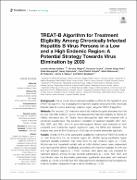| dc.description.abstract | Background: Little is known about treatment eligibility in Africa for the hepatitis B virus (TREAT-B) algorithm. We investigated the treatment eligibility among the HBV chronically infected patients in a low and a high endemic region using the TREAT-B algorithm.
Methods: We recruited 227 treatment-naïve HBV-infected hospital attendees from the low and high HBV endemic regions. We assessed the treatment eligibility by testing for HBeAg serostatus and ALT levels. Socio-demographic data were collected with a structured questionnaire. The accessory correlates of treatment eligibility (AST, ALP, ALB, GGT, and TBIL) and the socio-demographic factors were analyzed by both univariate and multinomial logistic regression using the SPSS and Medcalc. The analysis was done at 95% CI and a p < 0.05 was considered statistically significant.
Results: Overall, 56.8% of the participants qualified for treatment at TREAT-B cutoffs of ≥2, with those from the low endemic region (90, 69.8%) having significantly higher treatment eligibility indication than those from the high endemic region (p < 0.05). Alcohol use and household contact with an HBV-infected person were independent socio-demographic factors significantly associated with treatment eligibility for both low and high endemic regions (p < 0.05). However, birth place was only indicated for treatment eligibility among the high endemic participants (p < 0.05). AST, GGT, and total bilirubin were the liver-related parameters significantly associated with treatment eligibility (p < 0.05), with GGT and AST being significantly elevated among the eligible low endemic dwellers compared to high endemic dwellers (p < 0.05).
Conclusion: Using TREAT-B algorithm can be a plausible alternative to the orthodox methods to specify treatment eligibility with the potential to scale up interventions targeting HBV management and elimination. | en_US |

